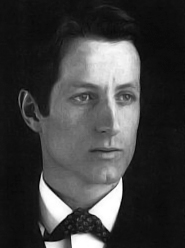Maxfield Parish
| Maxfield Parrish | |
|---|---|

Maxfield Parrish in 1896
|
|
| Born |
Frederick Parrish July 25, 1870 Philadelphia, Pennsylvania |
| Died | March 30, 1966 (aged 95) Plainfield, New Hampshire |
| Nationality | American |
| Education | Haverford College |
| Known for | Painter, illustrator |
| Spouse(s) | Lydia Ambler Austin |
Maxfield Parrish (July 25, 1870 – March 30, 1966) was an American painter and illustrator active in the first half of the 20th century. He is known for his distinctive saturated hues and idealized neo-classical imagery.
Born in Philadelphia, Pennsylvania, he was the son of painter and etcher Stephen Parrish. His mother was Elizabeth Bancroft. He began drawing for his own amusement as a child. He was raised in a Quaker society. His given name was Frederick Parrish, but he later adopted the maiden name of his paternal grandmother, Maxfield, as his middle name, and later as his professional name. Young Parrish's parents encouraged his talent. In 1884, his parents took Parrish to Europe. He toured England, Italy, and France. Parrish was exposed to architecture and the paintings from the old masters. They returned in 1886. During their travels, however, Parrish studied at the Paris school of a Dr. Kornemann.
He attended the Haverford School and later studied architecture at Haverford College for two years beginning in 1888. From 1892 to 1895, he studied at the Pennsylvania Academy of the Fine Arts to further his education in art. He studied under artists Robert Vonnoh and Thomas Pollock Anshutz. After graduating from the program, Parrish went to Annisquam, Massachusetts where he and his father shared a painting studio. A year later, he attended the Drexel Institute of Art, Science & Industry with his father's encouragement.
Parrish entered into an artistic career that lasted for more than half a century, and which helped shape the Golden Age of illustration and American visual arts. During his career, he produced almost 900 pieces of art including calendars, greeting cards, and magazine covers. Parrish's early works were mostly in black and white.
...
Wikipedia
